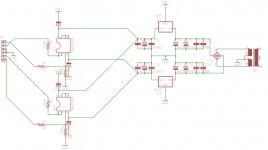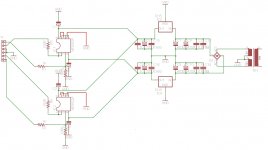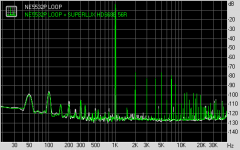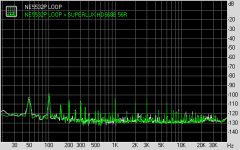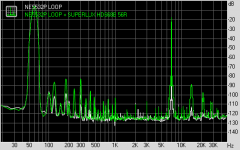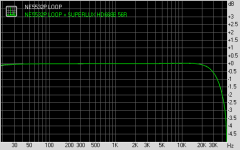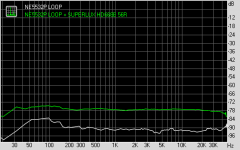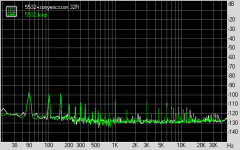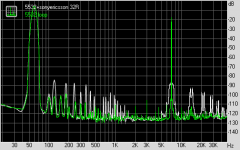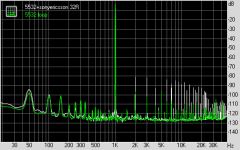hi , i spent 100 hours literaly searching for simple yet good sounding headphone amplifier , after that 100 hours i seen someone mentions using few paralelled opamps to power headphones and then i just connected rca to 3.5mm connector to my active crossover ne5532p loop out and that to my 56ohm headphones, ignoring fact that i put 100ohms resistor in series with 5532 output so relay when turned off wouldnt be dead short on opamp.
what concerns me is fact that this produces lot better sound than my pc soundcard output , and lot better channel separation as each 5532 sits on its own channel , no audible noise on headphones at all . should i remove the 100 ohms series resistor will that make things worse ?
psu is +-15v regulated with 7815 and 7915 and with lot of capacitance before regulators while after regs only 440uf all bypased by various small blocks.
5532 are 1k input with 100k to ground , unity ,100ohms from out to relays and that to connection
my question is why this sounds good and why there is no thread for this matter
what concerns me is fact that this produces lot better sound than my pc soundcard output , and lot better channel separation as each 5532 sits on its own channel , no audible noise on headphones at all . should i remove the 100 ohms series resistor will that make things worse ?
psu is +-15v regulated with 7815 and 7915 and with lot of capacitance before regulators while after regs only 440uf all bypased by various small blocks.
5532 are 1k input with 100k to ground , unity ,100ohms from out to relays and that to connection
my question is why this sounds good and why there is no thread for this matter
i stopped reading around page 5 , this is also multiple opamps paralelled , why one opamp per channel sound good i still cant find answer
This is no big secret.😉
It works even better on a lower supply voltage. Two in parallel work even better.
Even though it's way outside the operating parameter for load impedance, the feedback compensates to a very large degree. In fact, many power amplifiers are quite nonlinear without feedback applied. Same for op amps.
If you think that this sounds great, you should hear a 5532 buffered with a 49600 inside the feedback loop.
It works even better on a lower supply voltage. Two in parallel work even better.
Even though it's way outside the operating parameter for load impedance, the feedback compensates to a very large degree. In fact, many power amplifiers are quite nonlinear without feedback applied. Same for op amps.
If you think that this sounds great, you should hear a 5532 buffered with a 49600 inside the feedback loop.
depends on headphones - load Z (Ohms) and sensitivity (dB SPL re 1mW or 1 Vrms)
if you need only single digit mA, less than a Volt or two to drive your headphones then many op amps can do the job adequately
"sounds good" really needs checking by controlled listening test - frequency response and level matching with a Blinding protocol
a common result is that many situations audiophile's are raving about "night and day" differences it turns out that they can't tell a statistically significant difference in controlled listening tests
if you need only single digit mA, less than a Volt or two to drive your headphones then many op amps can do the job adequately
"sounds good" really needs checking by controlled listening test - frequency response and level matching with a Blinding protocol
a common result is that many situations audiophile's are raving about "night and day" differences it turns out that they can't tell a statistically significant difference in controlled listening tests
10 Ohms at the outputs is too low for stability into capacitive loads. 47R is about right. Take care with supply decoupling.
PC audio tends to use the RC4558, which struggles to drive 30R headphones
PC audio tends to use the RC4558, which struggles to drive 30R headphones
The 5532 is an amazing op amp. For headphone use the voltage output is only around 1V or so, and if you power the 5532 with +/-12V or more it can easily drive very, very low loads (for an op-amp) like 100R. If you asked it to do this at higher voltages distortion will become higher, and even into 100R the distortion is not as low as you can go, but as you mentioned it is better than many products out there.
I designed a 5532 headphone PCB that can be populated with up to 8 5532s per channel driven from an LME49720 input buffer. I tested it with 1, 4, or 8 devices installed into a 32R load and I found that the distortion even with one device was still very low compared to a speaker or headphone (0.01% or less). As you went to 4 or 8 5532s the distortion fell to below 0.001%. This was all at around 1Vrms output level.
As davidrsb mentions, you should connect the power supply pins at the socket with a 0.1uF bypass cap (I used MLCC ceramic types) on the 5532. Other than that, it's not too fussy.
I designed a 5532 headphone PCB that can be populated with up to 8 5532s per channel driven from an LME49720 input buffer. I tested it with 1, 4, or 8 devices installed into a 32R load and I found that the distortion even with one device was still very low compared to a speaker or headphone (0.01% or less). As you went to 4 or 8 5532s the distortion fell to below 0.001%. This was all at around 1Vrms output level.
As davidrsb mentions, you should connect the power supply pins at the socket with a 0.1uF bypass cap (I used MLCC ceramic types) on the 5532. Other than that, it's not too fussy.
10 Ohms at the outputs is too low for stability into capacitive loads. 47R is about right. Take care with supply decoupling.
PC audio tends to use the RC4558, which struggles to drive 30R headphones
Which is where the 4556 comes in. It is basically a 4558 with a higher current capability. Most of my Japanese devices used a single NJM4556 for the headphone output.
It is specced to be capable of putting 70 mA into 150 Ohms headphones.
In this thread there's a design that parallels 4 of them for driving even lower impedances.
ok i should probably go in more detail then, as i would want to pull max out of one 5532 as headphone amplifier and not going into paralleling more ,or buffering with some other opamp , i would like to keep it as simple as possible and as better it can go in driving headphones.
i am using superlux-hd-668-b headphones(98 db SPL/1mW) ,cheap akg clones but i never tryed akgs so this should suffice for long time,i put partial eagle schematics of how it looks now and i ask what to improove while not going more active devices if possible. first question being should i remove 100R in series with output. one note this is actualy built with preamp in mind but i had extra 2 stages so what the hell.
i am using superlux-hd-668-b headphones(98 db SPL/1mW) ,cheap akg clones but i never tryed akgs so this should suffice for long time,i put partial eagle schematics of how it looks now and i ask what to improove while not going more active devices if possible. first question being should i remove 100R in series with output. one note this is actualy built with preamp in mind but i had extra 2 stages so what the hell.
Attachments
Headphones respond differently to source impedance. Some like low amp impedance, some like higher. Japanese vintage receivers have excellent sounding headphone jacks, all they do is pad down the speaker signal with resistors, so the HP Zo is pretty high. Tube amps sound so good, in part, because they have higher output impedance than most SS amps. Read the details about this in the book "Current driving of Loudspeakers."
Single driver speakers (like headphones) sometimes have a shouty sound which is cured by reducing electrical damping by raising the output impedance. I was at a headphone meet this weekend where there was a couple dozen different amps that I tried with AKGK701. Most of the SS amps were shouty, but the tube amps were not, this is due to the output impedance being higher.
There was a cool headphone accessory there, called CanOpener which is just a box with resistor pad inside, with speaker level input binding posts on one side, 1/4" can jack on the other side. This won't be ideal for every headphone as some do prefer low impedance source. My point is that you keep asking about removing the 100ohm resistors, but it may be that you want to increase them.
You don't need resistors for short circuit protection because the IC has that built in. So try it without, and try it even higher. If you get the shouty headphone sound, try higher output impedance.
Single driver speakers (like headphones) sometimes have a shouty sound which is cured by reducing electrical damping by raising the output impedance. I was at a headphone meet this weekend where there was a couple dozen different amps that I tried with AKGK701. Most of the SS amps were shouty, but the tube amps were not, this is due to the output impedance being higher.
There was a cool headphone accessory there, called CanOpener which is just a box with resistor pad inside, with speaker level input binding posts on one side, 1/4" can jack on the other side. This won't be ideal for every headphone as some do prefer low impedance source. My point is that you keep asking about removing the 100ohm resistors, but it may be that you want to increase them.
You don't need resistors for short circuit protection because the IC has that built in. So try it without, and try it even higher. If you get the shouty headphone sound, try higher output impedance.
Headphones respond differently to source impedance. Some like low amp impedance, some like higher. Japanese vintage receivers have excellent sounding headphone jacks, all they do is pad down the speaker signal with resistors, so the HP Zo is pretty high. Tube amps sound so good, in part, because they have higher output impedance than most SS amps. Read the details about this in the book "Current driving of Loudspeakers."
Single driver speakers (like headphones) sometimes have a shouty sound which is cured by reducing electrical damping by raising the output impedance. I was at a headphone meet this weekend where there was a couple dozen different amps that I tried with AKGK701. Most of the SS amps were shouty, but the tube amps were not, this is due to the output impedance being higher.
There was a cool headphone accessory there, called CanOpener which is just a box with resistor pad inside, with speaker level input binding posts on one side, 1/4" can jack on the other side. This won't be ideal for every headphone as some do prefer low impedance source. My point is that you keep asking about removing the 100ohm resistors, but it may be that you want to increase them.
You don't need resistors for short circuit protection because the IC has that built in. So try it without, and try it even higher. If you get the shouty headphone sound, try higher output impedance.
exactly that , it doesnt produce shouty sound like standard headphone outputs, and it feels like there is more difference between different songs what i prefer,or should i say i dont like when different music sounds like it is recorded on same level when i know its not.
i remember that i was looking for transistors at headphone output of jvc rk10l and was puzzled i couldnt find them.
hm thats nice as i have spare 4 position x2 switch so i could put
direct connection,100R,220R,470R and if i switch headphones only have to move switch position,and to test how sounds other combinations.
thank you on huge ammount of information !
about kurohane sound link i could try that also as i have some spare opamps collecting dust, when i try that i post results.
if anyone is interested in actual measurments of this combinations ,1 more question , is measuring done as measuring preamp loop but with connected headphones or is microphone necessary ,if microphone is needed there will be no measurments i am sorry.
A good splitter cable to connect both headphones and a soundcard input is entirely sufficient. If you can't get any good-quality ones (I hope my Cordial CFY 0,3 WYY will last me a while, its not-much-cheaper predecessor also looked and measured good at first but developed issues within a year), make one yourself.
Years ago I did some loopback measurements with a slightly tweaked BTech BT928 amp in the signal path - a single-NE5532 affair (Philips part btw), single supply 15 V= (I used a regulated 12 V supply, as there was audible hum with the stock AC adapter), all AC coupled, inverting (stock gain 10, but with the crummy tone control disabled, 4.7 proved better), 47R output. I found no indications of undue distortion while driving my 100 ohm HD590s to high levels.
Stock circuit - I forgot who drew this, must have been 2006-ish or even earlier?

I used this amplifier (with tone control caps removed, 47k replacing 100k, and 220µ output coupling caps) as bedside-fi on an FM tuner for years, until the power supply eventually failed (mechanically). Its replacement (a FiiO E11) offers much lower output impedance, and the headphones appreciate that. Channel balance at lower volumes is better, too. The pot in the BTech was very cheap anyway, it already started scratching after about a year (but once some suitable sealing contact cleaner was applied, never acted up again).
This amplifier had one feature which made measuring distortion reliably a fair bit easier - two outputs with each having their own set of 47R output resistors. In case of shared resistors (as with a splitter cable), the headphones may impart some of their own distortion onto the recorded signal. Which can also be handy if you want to look at headphone and output impedance interaction on frequency response.
Years ago I did some loopback measurements with a slightly tweaked BTech BT928 amp in the signal path - a single-NE5532 affair (Philips part btw), single supply 15 V= (I used a regulated 12 V supply, as there was audible hum with the stock AC adapter), all AC coupled, inverting (stock gain 10, but with the crummy tone control disabled, 4.7 proved better), 47R output. I found no indications of undue distortion while driving my 100 ohm HD590s to high levels.
Stock circuit - I forgot who drew this, must have been 2006-ish or even earlier?

I used this amplifier (with tone control caps removed, 47k replacing 100k, and 220µ output coupling caps) as bedside-fi on an FM tuner for years, until the power supply eventually failed (mechanically). Its replacement (a FiiO E11) offers much lower output impedance, and the headphones appreciate that. Channel balance at lower volumes is better, too. The pot in the BTech was very cheap anyway, it already started scratching after about a year (but once some suitable sealing contact cleaner was applied, never acted up again).
This amplifier had one feature which made measuring distortion reliably a fair bit easier - two outputs with each having their own set of 47R output resistors. In case of shared resistors (as with a splitter cable), the headphones may impart some of their own distortion onto the recorded signal. Which can also be handy if you want to look at headphone and output impedance interaction on frequency response.
Last edited:
.
It appears that you have unused sections of two NE5532s floating. It might be better to terminate them as shown.
The idea is to have an input of ground, and then a unity gain of...ground. Which of course results in nothing.
Floating unused op amp sections can cause unexpected things to happen under some conditions. Terminating unused sections removes a variable.
.
It appears that you have unused sections of two NE5532s floating. It might be better to terminate them as shown.
The idea is to have an input of ground, and then a unity gain of...ground. Which of course results in nothing.
Floating unused op amp sections can cause unexpected things to happen under some conditions. Terminating unused sections removes a variable.
.
Attachments
Better yet, make use of the second half, apheared-47 style. (Note that that the opamp performing voltage gain may appreciate a small capacitor of maybe 33-47 pF from output to -in, and/or a small output series resistor may be helpful. Stability might actually improve when going from 47 to 10 ohm combining resistors.)
Better yet, make use of the second half, apheared-47 style. (Note that that the opamp performing voltage gain may appreciate a small capacitor of maybe 33-47 pF from output to -in, and/or a small output series resistor may be helpful. Stability might actually improve when going from 47 to 10 ohm combining resistors.)
actualy other halfs of 5532 are used as this is only part of schematics. i will try all combinations posted here as soon as i can,. question about measuring headphones without microphone, i measured loop of this with and without headphones attached with rightmark, and diferennces are minimal and i think this isnt valid method of measuring headphones but what the hell i put results in attach. output resistance both to headphones and line in of sound card is 0R in this case.
Attachments
hm there might be some truth in this measurments , here is measurments with 32R sonyericsson in ear headphones attached.
Attachments
measuring the V driving the headphone is the highest resolution for seeing amplifier effects
amp series output Z however does react with headphone Z - which for most headphone types varies with frequency - so you may see frequency response differences between different headphone as loads and pure resistors of the same nominal Z
amp series output Z however does react with headphone Z - which for most headphone types varies with frequency - so you may see frequency response differences between different headphone as loads and pure resistors of the same nominal Z
Kind of odd that nobody has mentioned the Cmoy - basically a single opamp driving headphones.
CMoy - Wikipedia, the free encyclopedia
CMoy - Wikipedia, the free encyclopedia
Kind of odd that nobody has mentioned the Cmoy - basically a single opamp driving headphones.
CMoy - Wikipedia, the free encyclopedia
kind of odd i heard about cmoy but i thought it was using lm386 and skipped it couse of lm386 poor performance and noise.
- Status
- Not open for further replies.
- Home
- Amplifiers
- Headphone Systems
- single NE5532P headphone amp ?!
